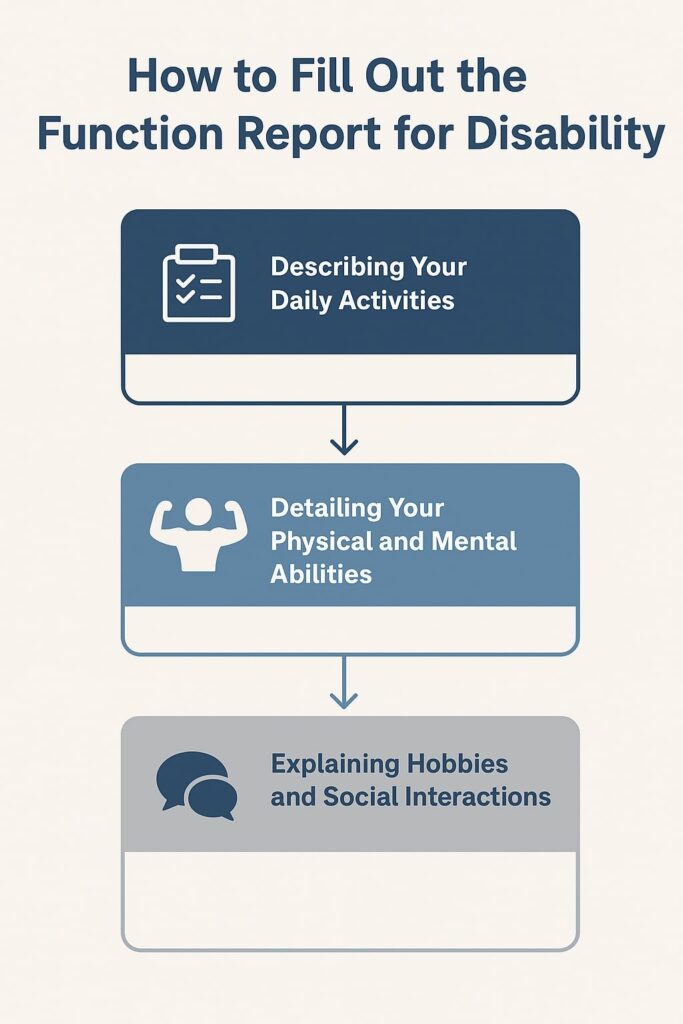While medical records provide a clinical picture of your condition, the Social Security Function Report, also known as Form SSA-3373, is your opportunity to paint a detailed, personal portrait of how your impairments affect your daily life.
The Social Security Administration (SSA) uses the information you provide to understand your limitations in a real-world context. They want to know what you can and cannot do on a typical day. Filling out this 10-page document can feel overwhelming, but understanding its purpose and how to approach each section thoughtfully can significantly strengthen your disability claim.
What is Form SSA-3373?
Form SSA-3373 is a detailed questionnaire that asks about your daily activities, abilities, and limitations. It covers everything from how you handle personal care like dressing and bathing to your capacity for household chores, shopping, hobbies, and social interactions. The SSA sends this form to you after you file your initial application for disability benefits. Your answers provide the claims examiner with a firsthand account of your day-to-day reality, which they use to assess the severity of your condition.
Why It’s More Than Just a Form
The information you provide on the Social Security Function Report is used by the SSA to determine your Residual Functional Capacity (RFC). Your RFC is an assessment of what you can still do despite your physical and mental limitations. For example, it outlines how much you can lift and carry, how long you can sit or stand, and whether you can concentrate and follow instructions.
An SSA claims examiner creates your RFC by combining the objective medical evidence in your file with the subjective information you provide on your Function Report. If your medical records state you have severe degenerative disc disease, your Function Report can illustrate this by explaining that you can no longer sit for more than 20 minutes without severe pain, need to lie down multiple times a day, and are unable to lift a laundry basket. This personal context is crucial for helping the examiner understand how your medical condition truly limits your ability to work.
A Step-by-Step Guide: How to Fill Out the Function Report for Disability
Approaching the form section by section can make it much more manageable. The key is to be detailed, consistent, and honest. Vague answers can be misinterpreted, so use concrete examples whenever possible.

Describing Your Daily Activities
This section asks you to describe a typical day from the moment you wake up until you go to bed. Avoid short, simple answers like “I watch TV.” Instead, provide a detailed narrative that highlights your struggles.
- Be Specific: Explain what you do, how long it takes, and what assistance you need. For example, instead of saying, “I get ready for the day,” describe the process: “I wake up around 8 AM, but have to stay in bed for 30 minutes due to stiffness. It takes me 45 minutes to get dressed because of pain and fatigue, and I have to sit down twice during the process. My husband has to help me with buttons and tying my shoes.”
- Include Meal Preparation: Don’t just say, “I make breakfast.” Explain what you can make. “I can only prepare simple meals like toast or a bowl of cereal. I cannot stand at the stove for more than five minutes to cook eggs, and I often drop pans because of weakness in my hands.”
- Discuss Household Chores: Detail which chores you can do, which ones you can’t, and why. “I can wipe down counters, but I can no longer vacuum because pushing it causes severe back spasms. I haven’t been able to mop the floors in over a year.”
Detailing Your Physical and Mental Abilities
The form includes a series of checkboxes and short-answer questions about specific abilities. This is where you connect your symptoms to concrete tasks.
- Physical Abilities: Questions will ask about lifting, standing, walking, sitting, and reaching. When answering, use real-world examples. For lifting, state what you can lift (e.g., “a gallon of milk” but not “a full grocery bag”). For walking, specify the distance or time (“I can walk to my mailbox at the end of the driveway, but I have to stop and rest before walking back”).
- Mental Abilities: This section is critical for those with mental health conditions, cognitive impairments, or even physical conditions that cause “brain fog.” Questions cover memory, concentration, following instructions, and getting along with others. Instead of saying your memory is “bad,” provide an example: “I have to set alarms on my phone to remember to take my medication. I often forget what I was saying mid-sentence.”
Explaining Hobbies and Social Interactions
This section helps the SSA understand how your condition has impacted your quality of life. The goal is to show a decline in your level of activity. Describe the hobbies and social activities you enjoyed before your disability and explain why you can no longer do them.
Common Pitfalls: Mistakes to Avoid on Your Social Security Function Report
How you fill out your disability function report can be just as important as what you say. Avoiding these common mistakes will help maintain your credibility and strengthen your claim.
The Credibility Trap: Exaggeration vs. Understatement
Your credibility is one of your most valuable assets in a disability claim. Never exaggerate your symptoms, as claims examiners are trained to spot inconsistencies. If you say you can’t lift more than five pounds but a medical record notes you carried your 20-pound grandchild, it will create a red flag.
On the other hand, do not downplay your limitations. Be completely honest about your struggles. Your answers should align with the information in your medical records and the reports from your doctors.
The Danger of Blank Spaces
Leaving a question blank can be interpreted by the SSA in a way that hurts your claim. For instance, if you leave the section on driving blank, the examiner might assume you have no problems with it. If a question doesn’t apply to you, write “Not applicable” or “N/A.” If you don’t do a certain activity, explain why.
The Hidden Impact: Forgetting Medication Side Effects
The medications you take to manage your condition can have their own debilitating side effects, and it’s crucial to include them in your report. Side effects like drowsiness, dizziness, nausea, “brain fog,” or the need to be near a restroom can significantly impact your ability to sustain work-like activities.
Finalizing Your Report for Maximum Impact
Once you’ve filled out the form, a few final steps can ensure it presents the clearest and most effective picture of your limitations.
Leveraging the “Remarks” Section
Section E of the form, titled “Remarks,” is your opportunity to provide additional information that didn’t fit neatly into the previous sections. Do not leave this section blank. This is the perfect place to:
- Explain “Good Days vs. Bad Days”: Most people with chronic conditions have variability in their symptoms. Use this space to explain what a “bad day” looks like and how frequently they occur. For example, “On a good day, I can sit for 30 minutes, but on a bad day, which happens 3-4 times a week, I can barely get out of bed due to pain.”
- Add Context: Provide any clarifying details that you feel are important for the examiner to know.
- Summarize Your Condition: You can use this space to offer a brief, powerful summary of your primary limitations and how they prevent you from working.
The Final Read-Through: Ensuring Consistency
Before you mail the form, read through your entire report one last time. Check for consistency. Do your descriptions of daily activities align with the limitations you listed in the specific questions? Inconsistencies, even if unintentional, can damage your credibility. It can be helpful to have a trusted friend or family member read it as well to see if it presents a clear and consistent picture of your struggles.
Contact National Disability Benefits for more information about Form SSA-3373
Navigating the complexities of how to fill out the function report for disability can be a daunting task, especially when you are already managing a serious health condition. The Social Security Function Report is a detailed and nuanced document where every answer matters. Ensuring it is completed accurately, thoroughly, and consistently is vital to the success of your disability claim.
If you are feeling overwhelmed or unsure about how to best represent your limitations, you don’t have to go through it alone. At National Disability Benefits, our experienced advocates understand exactly what the Social Security Administration is looking for. We can help you navigate this critical form and the entire disability application process.
Contact us today for a free consultation to learn how we can help you build the strongest case possible.


